Ashes to Space - Remote Portraits for the New York Times Magazine's Space Issue
How a virtual photoshoot comes together.
Welcome to In the Flash, a weekly, behind-the-lens dialogue on photography. To join the conversation
In the beginning of October, Kathy Ryan, the director for the New York Times Magazine, reached out about a shoot for the magazine’s annual Space issue —portraits of eight subjects who have chosen to send their ashes to space after they die. It was a dream assignment, except that the people were scattered across the US, and I had two weeks before flying out to Japan. Fitting so much travel in the time allotted would have been impossible, and I had no choice but to turn the assignment down. Unless the magazine would take me up on a wild proposition — to photograph all the people remotely through a smartphone. Besides logistics, the remote process felt perfectly fitted for the story about people reimagining their funeral with a sci-fi flair. To my surprise, the magazine agreed.


